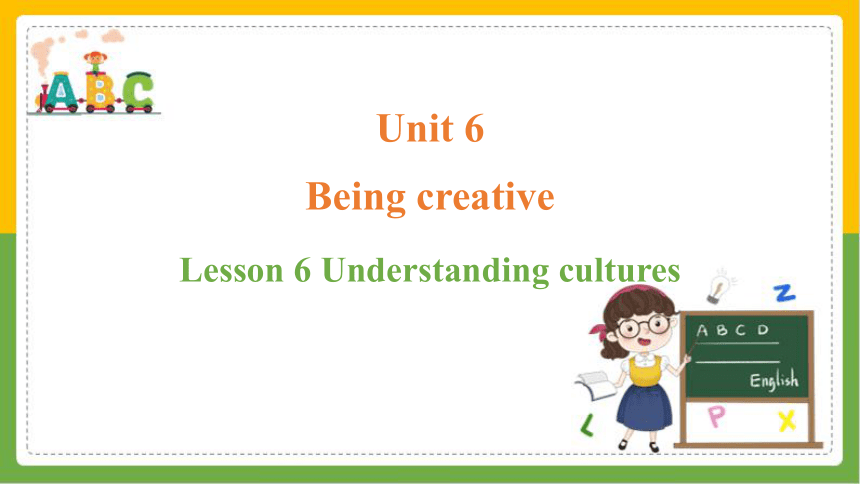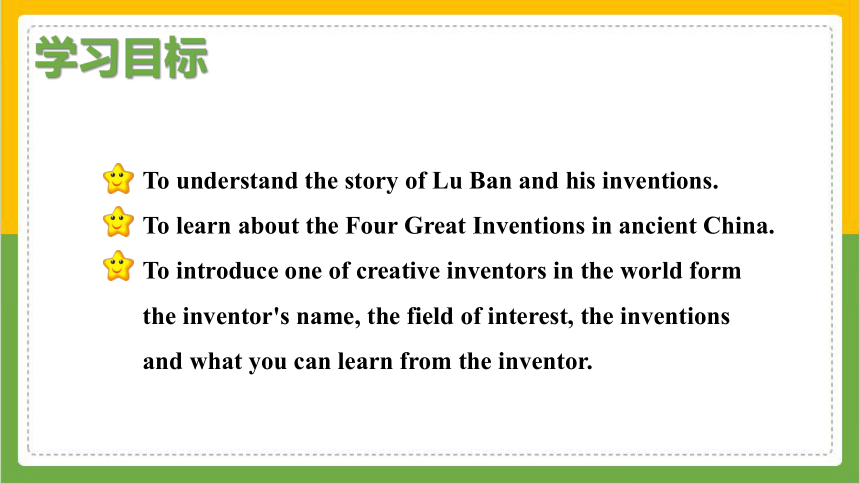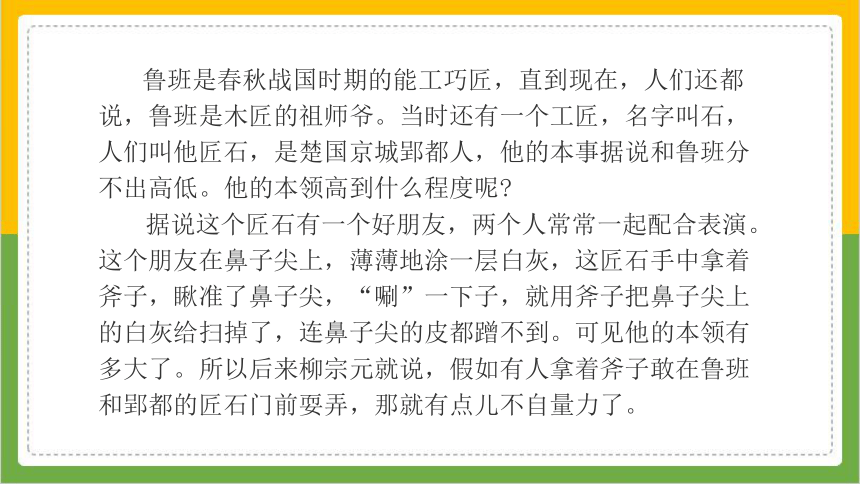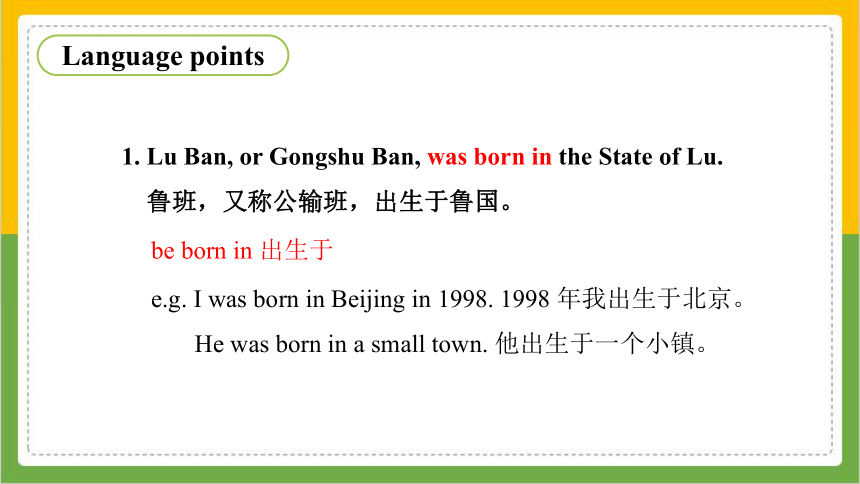Unit 6 Being creative Lesson 6课件(共19张PPT)冀教版(2024)七年级下册
文档属性
| 名称 | Unit 6 Being creative Lesson 6课件(共19张PPT)冀教版(2024)七年级下册 |  | |
| 格式 | pptx | ||
| 文件大小 | 684.2KB | ||
| 资源类型 | 教案 | ||
| 版本资源 | 冀教版 | ||
| 科目 | 英语 | ||
| 更新时间 | 2025-04-16 15:58:32 | ||
图片预览







文档简介
(共19张PPT)
Lesson 6 Understanding cultures
Unit 6
Being creative
To understand the story of Lu Ban and his inventions.
To learn about the Four Great Inventions in ancient China.
To introduce one of creative inventors in the world form the inventor's name, the field of interest, the inventions and what you can learn from the inventor.
学习目标
Read the passage and answer the questions.
Lu Ban, or Gongshu Ban, was born in the State of Lu.
When he was young, Lu Ban worked with his family. He was a quick learner. He was also creative. He had great interest in inventing new tools.
One day, Lu Ban cut his finger on a leaf. He saw that the leaf had teeth on its edge. He realised that a toothed edge could make cutting easier. In the following days, Lu Ban invented the first saw in history.
Lu Ban invented many other things, such as grappling hooks and rams for fighting on boats and the “cloud ladder” for attacking walled towns.
He also helped build many bridges and palaces in the State of Lu and other states. He made a big difference in China.
新课讲授
Reading
A What do you learn after reading the third paragraph
B What is a "cloud ladder"
Learning tips: In Chinese, we have the phrase ban men nong fu. This phrase has something to do with Lu Ban. What does it mean Some people think we need to ban men nong fu sometimes. Do you agree with them
We learn that how Lu Ban invented the first saw in history.
It is for attacking walled towns.
鲁班是春秋战国时期的能工巧匠,直到现在,人们还都说,鲁班是木匠的祖师爷。当时还有一个工匠,名字叫石,人们叫他匠石,是楚国京城郢都人,他的本事据说和鲁班分不出高低。他的本领高到什么程度呢
据说这个匠石有一个好朋友,两个人常常一起配合表演。这个朋友在鼻子尖上,薄薄地涂一层白灰,这匠石手中拿着斧子,瞅准了鼻子尖,“唰”一下子,就用斧子把鼻子尖上的白灰给扫掉了,连鼻子尖的皮都蹭不到。可见他的本领有多大了。所以后来柳宗元就说,假如有人拿着斧子敢在鲁班和郢都的匠石门前耍弄,那就有点儿不自量力了。
1. Lu Ban, or Gongshu Ban, was born in the State of Lu.
鲁班,又称公输班,出生于鲁国。
e.g. I was born in Beijing in 1998. 1998 年我出生于北京。
He was born in a small town. 他出生于一个小镇。
Language points
be born in 出生于
2. He was a quick learner. 他学得很快。
e.g. She is a quick learner and can pick up new skills easily.
她是个学得快的人,能轻松掌握新技能。
quick learner 学习能力强的人;学得快的人
e.g. She has great interest in music.
她对音乐有感兴趣。
3. He had great interest in inventing new tools.
他对发明新工具很感兴趣。
have interest in 对......感兴趣
e.g. In this situation, a few seconds can make a big difference.
在这种情况下,短短几秒钟就可以产生很大的影响。
4. He made a big difference in China.
他在中国产生了巨大的影响。
make a (big) difference 起(重要)作用;有(很大)影响
The Four Great Inventions in ancient China greatly promoted the development of China and the world. Do you know what they are Look at the pictures and match them to their names. Then discuss with your classmates.
paper-making
printing
compass
gunpowder
Match and discuss
印刷
1. 雕版印刷术的发明与发展
雕版印刷术最早出现在唐朝(7世纪),其基本原理是将文字或图案雕刻在木板上,然后涂上墨汁,通过压力将其印刷到纸张上。这种方法极大地提高了书籍的生产效率,避免了手抄本的费时费力。现存最早的雕版印刷品是唐代的《金刚经》,显示了这一技术的初步应用 。
2. 活字印刷术的发明与影响
活字印刷术由北宋时期的毕昇发明,他使用了胶泥制作的单个方块体,每个方块上刻有一个汉字,通过将这些活字拼合在一起形成完整的印刷版。这种方法解决了雕版印刷的储存问题,提高了印刷的灵活性和效率。活字可以重复使用,降低了制作成本,推动了知识的广泛传播和社会进步 。
火药
火药的发明可以追溯到9世纪初,具体时间可能是唐朝时期。最初,火药是由古代中国的炼金术士们在炼丹过程中发现的。他们试图通过加热混合物来提炼出长生不老药,但在过程中意外地创造了火药 。
火药最初主要用于烟花和宗教仪式中,象征着驱邪避祟。到了宋朝(960-1279年),火药的军事应用开始显现,被用于火箭、火枪和大炮等武器,极大地增强了战斗力 2。宋朝的军事家们开始将火药应用于战争,标志着冷兵器时代向火器时代的转变 。
造纸术
造纸术的起源可以追溯到西汉时期,当时人们已经懂得了造纸的基本方法,使用大麻、苎麻等植物纤维制造纸张 。到了东汉时期,宦官蔡伦在前人经验的基础上,改进了造纸工艺,使用树皮、麻头、破布和旧渔网等原料,制造出了质量更高的纸张,这种纸被称为“蔡侯纸” 。蔡伦的改进使得纸张原料易找、价格便宜,易于推广,从而大大推动了纸的使用和普及 。
指南针
1. 起源:司南(战国时期)
指南针的前身是司南,最早出现在战国时期(公元前475年-公元前221年)。司南由天然磁石制成,形状如勺,放置于光滑的铜盘上,静止时勺柄指向南方。这一发明基于对磁石指极性的发现,主要用于祭祀、礼仪和军事等领域。
2. 发展:水罗盘与指南鱼(唐代至北宋)
水罗盘 :唐代末期,风水学中出现了水罗盘,其构造与司南不同,主要由可转动的磁针和刻度盘组成。唐代人还发现了磁偏角现象,即磁针并非完全指向地理南极。
指南鱼 :北宋时期,曾公亮描述了指南鱼的制作方法,即将铁片加热后按南北磁极朝向放置,冷却后磁化,放入水中即可指示方向。
3. 成熟:旱罗盘(南宋时期)
南宋时期,旱罗盘出现,其特点是将磁针用铜钉支撑,无需用水,定向更稳定。宋代指南针分为水罗盘和旱罗盘两种形式,后者因其精度和稳定性更受欢迎。
There are many creative inventors in the world. Work in groups and introduce one of them.
The following questions may help you:
What did he/she invent
What is his/her field of interest
What can you learn from him/her
Name of the inventor
Group work
Sample:
Edison inventing the light bulb did not 1500 many experiments to find suitable lamp filament material, it was ridiculed, he said: "Mr. Edison, you have failed in 1500 many times." Edison replied: "No l have not failed, l have done is found in more than 1500 kinds of materials are not suitable for the filament lamp. "After further testing, Edison found that the Japanese use bamboo charcoal for the best filament. Until 1906,Edison has to do to switch to tungsten, so that the quality has improved light bulb, has been in use to this days. From Edison, we know that no pains, no gains.
I can talk about the steps of making a hand-made product:
· First, we got different materials.
· Next, we cut the paper into a shape.
· Finally, we drew beautiful patterns on our kite.
I can talk about traditional Chinese handicrafts:
· Paper cutting is a traditional art form in China.
· People fly kites to express their wishes for a better life.
I can talk about DIY using reflexive pronouns:
· I made the monkey out of clay. I painted it myself.
· Did you make the costumes by yourself
improvement needed:
Self-check
DIY
In a world of imagination, where dreams unfold,
DIY becomes an adventure, a story yet untold.
With tools and creativity, we take our stand,
Transforming ordinary things with our hands.
Scissors cut, glue sticks, and paintbrushes dance,
As we craft and create, taking every chance.
Piece by piece, we shape our vision true.
DIY magic, bringing dreams to life anew.
Fun time
当堂检测
1. 他对弹钢琴很感兴趣。
He ______ ______ ________ ____ playing the piano.
2. 我的手指被书页边缘割伤了。
I cut my finger ____ _____ ______ _____ a book page.
3. 接下来几天的天气将主要是干燥和寒冷的。
The weather will be mainly dry and cold __ ___ ________ ____.
4. 历史上的这一发现改变了人们的日常生活。
The discovery ____ ________ changed people’s everyday life.
5. 我认为书籍可以对我们产生很大的影响。
I think books can _____ _____ ____ _________ _____ us.
根据汉语意思完成句子,每空一词
has great interest in
on the edge of
in the following days
in history
make a big difference to
Lesson 6 Understanding cultures
Unit 6
Being creative
To understand the story of Lu Ban and his inventions.
To learn about the Four Great Inventions in ancient China.
To introduce one of creative inventors in the world form the inventor's name, the field of interest, the inventions and what you can learn from the inventor.
学习目标
Read the passage and answer the questions.
Lu Ban, or Gongshu Ban, was born in the State of Lu.
When he was young, Lu Ban worked with his family. He was a quick learner. He was also creative. He had great interest in inventing new tools.
One day, Lu Ban cut his finger on a leaf. He saw that the leaf had teeth on its edge. He realised that a toothed edge could make cutting easier. In the following days, Lu Ban invented the first saw in history.
Lu Ban invented many other things, such as grappling hooks and rams for fighting on boats and the “cloud ladder” for attacking walled towns.
He also helped build many bridges and palaces in the State of Lu and other states. He made a big difference in China.
新课讲授
Reading
A What do you learn after reading the third paragraph
B What is a "cloud ladder"
Learning tips: In Chinese, we have the phrase ban men nong fu. This phrase has something to do with Lu Ban. What does it mean Some people think we need to ban men nong fu sometimes. Do you agree with them
We learn that how Lu Ban invented the first saw in history.
It is for attacking walled towns.
鲁班是春秋战国时期的能工巧匠,直到现在,人们还都说,鲁班是木匠的祖师爷。当时还有一个工匠,名字叫石,人们叫他匠石,是楚国京城郢都人,他的本事据说和鲁班分不出高低。他的本领高到什么程度呢
据说这个匠石有一个好朋友,两个人常常一起配合表演。这个朋友在鼻子尖上,薄薄地涂一层白灰,这匠石手中拿着斧子,瞅准了鼻子尖,“唰”一下子,就用斧子把鼻子尖上的白灰给扫掉了,连鼻子尖的皮都蹭不到。可见他的本领有多大了。所以后来柳宗元就说,假如有人拿着斧子敢在鲁班和郢都的匠石门前耍弄,那就有点儿不自量力了。
1. Lu Ban, or Gongshu Ban, was born in the State of Lu.
鲁班,又称公输班,出生于鲁国。
e.g. I was born in Beijing in 1998. 1998 年我出生于北京。
He was born in a small town. 他出生于一个小镇。
Language points
be born in 出生于
2. He was a quick learner. 他学得很快。
e.g. She is a quick learner and can pick up new skills easily.
她是个学得快的人,能轻松掌握新技能。
quick learner 学习能力强的人;学得快的人
e.g. She has great interest in music.
她对音乐有感兴趣。
3. He had great interest in inventing new tools.
他对发明新工具很感兴趣。
have interest in 对......感兴趣
e.g. In this situation, a few seconds can make a big difference.
在这种情况下,短短几秒钟就可以产生很大的影响。
4. He made a big difference in China.
他在中国产生了巨大的影响。
make a (big) difference 起(重要)作用;有(很大)影响
The Four Great Inventions in ancient China greatly promoted the development of China and the world. Do you know what they are Look at the pictures and match them to their names. Then discuss with your classmates.
paper-making
printing
compass
gunpowder
Match and discuss
印刷
1. 雕版印刷术的发明与发展
雕版印刷术最早出现在唐朝(7世纪),其基本原理是将文字或图案雕刻在木板上,然后涂上墨汁,通过压力将其印刷到纸张上。这种方法极大地提高了书籍的生产效率,避免了手抄本的费时费力。现存最早的雕版印刷品是唐代的《金刚经》,显示了这一技术的初步应用 。
2. 活字印刷术的发明与影响
活字印刷术由北宋时期的毕昇发明,他使用了胶泥制作的单个方块体,每个方块上刻有一个汉字,通过将这些活字拼合在一起形成完整的印刷版。这种方法解决了雕版印刷的储存问题,提高了印刷的灵活性和效率。活字可以重复使用,降低了制作成本,推动了知识的广泛传播和社会进步 。
火药
火药的发明可以追溯到9世纪初,具体时间可能是唐朝时期。最初,火药是由古代中国的炼金术士们在炼丹过程中发现的。他们试图通过加热混合物来提炼出长生不老药,但在过程中意外地创造了火药 。
火药最初主要用于烟花和宗教仪式中,象征着驱邪避祟。到了宋朝(960-1279年),火药的军事应用开始显现,被用于火箭、火枪和大炮等武器,极大地增强了战斗力 2。宋朝的军事家们开始将火药应用于战争,标志着冷兵器时代向火器时代的转变 。
造纸术
造纸术的起源可以追溯到西汉时期,当时人们已经懂得了造纸的基本方法,使用大麻、苎麻等植物纤维制造纸张 。到了东汉时期,宦官蔡伦在前人经验的基础上,改进了造纸工艺,使用树皮、麻头、破布和旧渔网等原料,制造出了质量更高的纸张,这种纸被称为“蔡侯纸” 。蔡伦的改进使得纸张原料易找、价格便宜,易于推广,从而大大推动了纸的使用和普及 。
指南针
1. 起源:司南(战国时期)
指南针的前身是司南,最早出现在战国时期(公元前475年-公元前221年)。司南由天然磁石制成,形状如勺,放置于光滑的铜盘上,静止时勺柄指向南方。这一发明基于对磁石指极性的发现,主要用于祭祀、礼仪和军事等领域。
2. 发展:水罗盘与指南鱼(唐代至北宋)
水罗盘 :唐代末期,风水学中出现了水罗盘,其构造与司南不同,主要由可转动的磁针和刻度盘组成。唐代人还发现了磁偏角现象,即磁针并非完全指向地理南极。
指南鱼 :北宋时期,曾公亮描述了指南鱼的制作方法,即将铁片加热后按南北磁极朝向放置,冷却后磁化,放入水中即可指示方向。
3. 成熟:旱罗盘(南宋时期)
南宋时期,旱罗盘出现,其特点是将磁针用铜钉支撑,无需用水,定向更稳定。宋代指南针分为水罗盘和旱罗盘两种形式,后者因其精度和稳定性更受欢迎。
There are many creative inventors in the world. Work in groups and introduce one of them.
The following questions may help you:
What did he/she invent
What is his/her field of interest
What can you learn from him/her
Name of the inventor
Group work
Sample:
Edison inventing the light bulb did not 1500 many experiments to find suitable lamp filament material, it was ridiculed, he said: "Mr. Edison, you have failed in 1500 many times." Edison replied: "No l have not failed, l have done is found in more than 1500 kinds of materials are not suitable for the filament lamp. "After further testing, Edison found that the Japanese use bamboo charcoal for the best filament. Until 1906,Edison has to do to switch to tungsten, so that the quality has improved light bulb, has been in use to this days. From Edison, we know that no pains, no gains.
I can talk about the steps of making a hand-made product:
· First, we got different materials.
· Next, we cut the paper into a shape.
· Finally, we drew beautiful patterns on our kite.
I can talk about traditional Chinese handicrafts:
· Paper cutting is a traditional art form in China.
· People fly kites to express their wishes for a better life.
I can talk about DIY using reflexive pronouns:
· I made the monkey out of clay. I painted it myself.
· Did you make the costumes by yourself
improvement needed:
Self-check
DIY
In a world of imagination, where dreams unfold,
DIY becomes an adventure, a story yet untold.
With tools and creativity, we take our stand,
Transforming ordinary things with our hands.
Scissors cut, glue sticks, and paintbrushes dance,
As we craft and create, taking every chance.
Piece by piece, we shape our vision true.
DIY magic, bringing dreams to life anew.
Fun time
当堂检测
1. 他对弹钢琴很感兴趣。
He ______ ______ ________ ____ playing the piano.
2. 我的手指被书页边缘割伤了。
I cut my finger ____ _____ ______ _____ a book page.
3. 接下来几天的天气将主要是干燥和寒冷的。
The weather will be mainly dry and cold __ ___ ________ ____.
4. 历史上的这一发现改变了人们的日常生活。
The discovery ____ ________ changed people’s everyday life.
5. 我认为书籍可以对我们产生很大的影响。
I think books can _____ _____ ____ _________ _____ us.
根据汉语意思完成句子,每空一词
has great interest in
on the edge of
in the following days
in history
make a big difference to
同课章节目录
